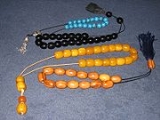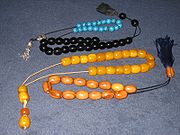
Kombolói
Encyclopedia

Culture of Greece
The culture of Greece has evolved over thousands of years, beginning in Mycenaean Greece, continuing most notably into Classical Greece, through the influence of the Roman Empire and its Greek Eastern successor the Byzantine Empire...
and Cyprus culture, used to relieve stress
Stress (medicine)
Stress is a term in psychology and biology, borrowed from physics and engineering and first used in the biological context in the 1930s, which has in more recent decades become commonly used in popular parlance...
, keep hands and fingers occupied and generally pass the time. It was especially popular up to the end of the 20th century while now it has dropped in popular use. However, it is still considered a symbol of Greek (and especially rembetiki
Rebetiko
Rebetiko, plural rebetika, , occasionally transliterated as Rembetiko, is a term used today to designate originally disparate kinds of urban Greek folk music which have come to be grouped together since the so-called rebetika revival, which started in the 1960s and developed further from the early...
) culture and a niche.
Etymology
Modern Greek κομπολόι is derived from medieval GreekMedieval Greek
Medieval Greek, also known as Byzantine Greek, is the stage of the Greek language between the beginning of the Middle Ages around 600 and the Ottoman conquest of the city of Constantinople in 1453. The latter date marked the end of the Middle Ages in Southeast Europe...
κομβολόγιον < κόμβος "knot" + -λόγιο "collection". On a different take on the etymology, κομπολόι is short for the phrase σε κάθε κόμπο προσευχή λέω, "in every knot I say a prayer"- κόμπο "knot"-λέω "say" > κόμπο-λέω > κομπολόι. This etymology accounts for the fact that κομπολόι evolved from κομποσκοίνι, the Greek word for prayer rope
Prayer rope
A prayer rope is a loop made up of complex knots, usually out of wool or silk....
.
Purpose and origin
Komboloi worry beads resemble prayer beadsPrayer beads
Prayer beads are used by members of various religious traditions such as Roman Catholicism, Orthodox Christianity, Anglicanism, Islam, Hinduism, Buddhism, Sikhism and Bahá'í Faith to count the repetitions of prayers, chants or devotions, such as the rosary of Virgin Mary in Christianity and dhikr ...
, but, unlike them, do not necessarily bear religious significance. Some collectors enjoy them for religious devotions, and seek komboloi with 33 beads to represent the life of Christ. In modern times komboloi are also used by people who want to limit smoking
Smoking
Smoking is a practice in which a substance, most commonly tobacco or cannabis, is burned and the smoke is tasted or inhaled. This is primarily practised as a route of administration for recreational drug use, as combustion releases the active substances in drugs such as nicotine and makes them...
.
The origin of the Greek komboloi is debated. It may derive from the komboskini used by Orthodox monks or the Islamic Misbaha. Armenians also have their own worry beads which serve the same purpose as the komboloi and are also non-religious in nature.
Features


Amber
Amber is fossilized tree resin , which has been appreciated for its color and natural beauty since Neolithic times. Amber is used as an ingredient in perfumes, as a healing agent in folk medicine, and as jewelry. There are five classes of amber, defined on the basis of their chemical constituents...
, amber resin (such as faturan
Faturan
Faturan in Middle Eastern beadwork refers to a variety of synthetic resins such as Bakelite used as a sort of imitation amber to make beads, notably in the making of komboloi and misbaha.-History:...
) and coral
Coral
Corals are marine animals in class Anthozoa of phylum Cnidaria typically living in compact colonies of many identical individual "polyps". The group includes the important reef builders that inhabit tropical oceans and secrete calcium carbonate to form a hard skeleton.A coral "head" is a colony of...
are preferred, as they are thought to be more pleasant to handle than non-organic materials such as metal or minerals.
Greek komboloi generally have an odd number of beads (usually one more than a multiple of four, e.g. (4x4)+1, (5x4)+1, and so on) and usually have a head composed of a fixed bead (παπάς "priest"), a shield (θυρεός) to separate the two threads and help the beads to flow freely, and a tassel
Tassel
A tassel is a finishing feature in fabric decoration. It is a universal ornament that is seen in varying versions in many cultures around the globe.-Etymology:...
(φούντα). Usually the length of a komboloi is approximately two palm widths.
A variation of the komboloi with an especially long string, often with only two beads, is known as begleri (μπεγλέρι).
Komboloi often have a prime number of beads on the string, usually 17, 19 or 23. Those with spacer beads, usually metal, between the coloured plastic or glass ones, still have a total number which is a prime number, e.g. 37.
Use
Komboloi can be handled in many different ways. The most common are a quiet method, for indoors, and a noisier method that is acceptable in public places. The most common quiet method is to start at one end of the thread or chain, near the shield, and to pull the thread forward using that hand's thumb and the side of the index finger until one of the beads is reached. Then the cord is tipped so that the bead falls and hits the shield. This is repeated until all the beads have been tipped and then the user starts over.The second, louder, method is to divide the beads in to two groups. On one end is the shield and a small number of the beads. On the other end is the rest of the beads. Where the two threads are empty, that space is laid between the index and middle fingers. The hand should be in a position where the palm is facing the torso. Then the end behind the hand is swung up and forward so that it hits the other beads, making a noise. The threads are then switched back into the space between the index and middle fingers by holding the threads between the thumb and the side of the index finger. This is repeated rhythmically, creating a louder clicking noise than the quiet method. An easier and soothing method is to hold all of the kombolói in one hand and roll the beads against each other, creating soft clicking sounds.
A more modern version of these worry beads continues to gain increasing popularity. Sometimes called wigglers, these simple strings of beads can be used in a number of ways, including both one- and two-handed methods that involve rapidly wiggling the beads in various directions. Fans claim that wiggling the beads creates a rush of adrenaline, followed by a soothing, calm sensation.
See also
Culturally related articles:- MangasMangasManges is the name of a social group in the Belle Époque era's counterculture of Greece . The nearest English equivalent to the term mangas is wide boy, or spiv...
- RebetesRebetesA rebetis is a musician involved in the scene of the Greek musical genre of rebetiko, which flourished between 1920 and 1955.Prominent rebetes include:*Rita Abatzi*Babis Tsertos*Yiorgos Batis*Sotiria Bellou...
- RebetikoRebetikoRebetiko, plural rebetika, , occasionally transliterated as Rembetiko, is a term used today to designate originally disparate kinds of urban Greek folk music which have come to be grouped together since the so-called rebetika revival, which started in the 1960s and developed further from the early...
Similar items in other cultures:
- Baoding BallsBaoding BallsBaoding balls are also known as Chinese exercise balls, Chinese meditation balls, Chinese medicine balls, and healthy balls. They are a traditional product of Baoding, China, thought to have been created during the Ming dynasty...
- MalaJapa malaA Japa mala or mala is a set of beads commonly used by Hindus and Buddhists, usually made from 108 beads, though other numbers, usually divisible by 9, are also used. Malas are used for keeping count while reciting, chanting, or mentally repeating a mantra or the name or names of a deity...
- Misbaha
- Prayer ropePrayer ropeA prayer rope is a loop made up of complex knots, usually out of wool or silk....
- RosaryRosaryThe rosary or "garland of roses" is a traditional Catholic devotion. The term denotes the prayer beads used to count the series of prayers that make up the rosary...

